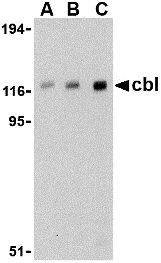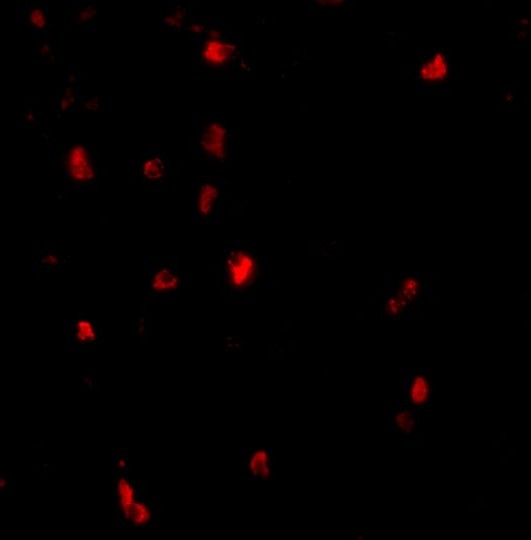Cbl Antibody
| Code | Size | Price |
|---|
| PSI-3967-0.02mg | 0.02mg | £150.00 |
Quantity:
| PSI-3967-0.1mg | 0.1mg | £449.00 |
Quantity:
Prices exclude any Taxes / VAT
Overview
Host Type: Rabbit
Antibody Isotype: IgG
Antibody Clonality: Polyclonal
Regulatory Status: RUO
Applications:
- Enzyme-Linked Immunosorbent Assay (ELISA)
- Immunofluorescence (IF)
- Western Blot (WB)
Images
Documents
Further Information
Additional Names:
Cbl Antibody: CBL2, NSLL, C-CBL, RNF55, FRA11B, CBL2, E3 ubiquitin-protein ligase CBL, Casitas B-lineage lymphoma proto-oncogene
Application Note:
Cbl antibody can be used for detection of cbl by Western blot at 0.5 - 2 μg/mL. Antibody can also be used for immunoflourescence starting at 20 μg/mL.
Antibody validated: Western Blot in human samples and Immunofluorescence in human samples. All other applications and species not yet tested.
Antibody validated: Western Blot in human samples and Immunofluorescence in human samples. All other applications and species not yet tested.
Background:
Cbl Antibody: The mammalian cbl family of ubiquitin ligases consists of three homologs known as cbl (also known as c-Cbl), Cbl-B, and Cbl-3 which share highly conserved a tyrosine-kinase-binding domain, linker and RING finger domain in their amino-terminal halves. Similar to other E3 ubiquitin ligases, Cbl catalyzes the transfer of ubiquitin from an E2 or Ubc (ubiquitin-conjugating) enzyme to the e-amino group of a lysine residue of the substrate protein. Cbl acts to negatively regulate many types of cell-surface receptors, including the Syk protein tyrosine kinase family. Cbl is thought to be involved in T- and B-cell signaling, in addition to thymus development. Of the three known homologs in the cbl family, cbl antibody reacts specifically with cbl. Multiple isoforms of cbl have been reported.
Background References:
- Thien CBF and Langdon WY. C-Cbl and Cbl-b ubiquitin ligases: substrate diversity and the negative regulation of signaling responses. Biochem. J. 2005; 391:153-66
- Weissman AM. Themes and variations on ubiquitylation. Nat. Rev. Mol. Cell Biol. 2001; 2:169-78.
- Swaminathan G and Tsygankov AY. The Cbl family of proteins: ring leaders in regulation of cell signaling. J. Cell. Physiol. 2006; 209:21-43.
Buffer:
Cbl Antibody is supplied in PBS containing 0.02% sodium azide.
Concentration:
1 mg/mL
Conjugate:
Unconjugated
DISCLAIMER:
Optimal dilutions/concentrations should be determined by the end user. The information provided is a guideline for product use. This product is for research use only.
Immunogen:
Cbl antibody was raised against a 14 amino acid synthetic peptide from near the carboxy terminus of human cbl.
The immunogen is located within amino acids 810 - 860 of Cbl.
The immunogen is located within amino acids 810 - 860 of Cbl.
NCBI Gene ID #:
867
NCBI Official Name:
Cas-Br-M (murine) ecotropic retroviral transforming sequence
NCBI Official Symbol:
CBL
NCBI Organism:
Homo sapiens
Physical State:
Liquid
Protein Accession #:
P22681
Protein GI Number:
115855
Purification:
Cbl Antibody is affinity chromatography purified via peptide column.
Research Area:
Signal Transduction,Cancer
Swissprot #:
P22681
User NOte:
Optimal dilutions for each application to be determined by the researcher.
Related Products
| Product Name | Product Code | Supplier | Cbl Peptide | PSI-3967P | ProSci | Summary Details | |||||||||||||||||||||||||||||||||||||||||||||||||||||||||||||||||||||||||||||||||||||||||||||
|---|---|---|---|---|---|---|---|---|---|---|---|---|---|---|---|---|---|---|---|---|---|---|---|---|---|---|---|---|---|---|---|---|---|---|---|---|---|---|---|---|---|---|---|---|---|---|---|---|---|---|---|---|---|---|---|---|---|---|---|---|---|---|---|---|---|---|---|---|---|---|---|---|---|---|---|---|---|---|---|---|---|---|---|---|---|---|---|---|---|---|---|---|---|---|---|---|---|---|---|




